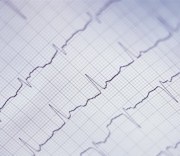Related terms: bbb, left bundle branch block (LBBB), right bundle branch block (RBBB), arrhythmia
Your heart has a natural "pacemaker" called the sinoatrial (SA) node which sends an electrical impulse throughout your heart to cause it to beat (contract). That electrical impulse from the SA node first travels through the heart's upper chambers (the atria). It then passes through a small group of cells called the atrioventricular (AV) node. The AV node checks the impulse and sends it along a track called the bundle of His. The bundle of His divides into a right bundle branch and a left bundle branch, which lead to your heart's lower chambers (the ventricles).
Sometimes part of the heart's conduction system is "blocked." If an impulse is blocked as it travels through the bundle branches, you are said to have bundle branch block.
For the left and right ventricles to contract at the same time, an electrical impulse must travel down the right and left bundle branches at the same speed. If there is a block in one of these branches, the electrical impulse must travel to the ventricle by a different route. When this happens, the rate and rhythm of your heartbeat are not affected, but the impulse is slowed. Your ventricle will still contract, but it will take longer because of the slowed impulse. This slowed impulse causes one ventricle to contract a fraction of a second slower than the other.
The medical terms for bundle branch block are derived from which branch is affected. If the block is located in the right bundle branch, it is called right bundle branch block. If the block is located in the left bundle branch, it is called left bundle branch block.
What causes bundle branch block?
The block can be caused by coronary artery disease, cardiomyopathy, or valve disease. Right bundle branch block may also occur in a healthy heart.
What are the symptoms?
If there is nothing else wrong with your heart, you probably will not feel any symptoms of bundle branch block. In fact, some people may have bundle branch block for years and never know they have the condition. In people who do have symptoms, they may faint (syncope) or feel as if they are going to faint (presyncope).
So why should we worry about bundle branch block? Because it can be a warning sign of other, more serious heart conditions. For example, it might mean that a small part of your heart is not getting enough oxygen-rich blood. Also, researchers have found that people who have left bundle branch block may be at greater risk for heart disease than are people who do not have the condition.
How is bundle branch block diagnosed?
Doctors can use an electrocardiogram (EKG or ECG) to record the electrical impulses of your heart. The electrical patterns can show bundle branch block and whether the block is located in the right or left bundle branch.
How is bundle branch block treated?
In most cases, bundle branch block does not need treatment. But patients who have bundle branch block along with another heart condition may need treatment. For example, if bundle branch block develops during a heart attack, you may need a pacemaker. After a heart attack, your heart is fragile, and bundle branch block may cause a very slow heart rhythm (bradycardia). A pacemaker helps regulate the heart's rhythm.
For patients with both bundle branch block and dilated cardiomyopathy, a new type of pacing called cardiac resynchronization treatment (CRT) may be used. Normally, pacemakers pace only one of the lower heart chambers (the ventricles) at a time. But CRT re-coordinates the beating of the two ventricles by pacing them at the same time.
Even if you do not have other conditions, you should still see your doctor regularly so that he or she can be sure there are no other changes in your heart.
See also on this site:



